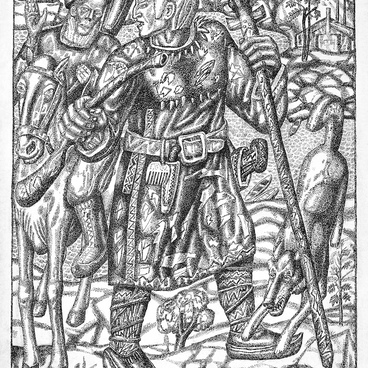Georgy Adamovich Stronk was an artist, graphic designer, and illustrator.
The image of Kullervo stands out among other characters from the epic poem “Kalevala”. He is a slave who seeks revenge on the entire world for his misfortunes. Kullervo has become part of Finnish literary history, adding a tragic dimension to it. This complex image is built upon fairy tales and songs about the birth of a superstrong boy, as well as traditional shepherd songs that often feature a poor, bereaved shepherd boy.
Since birth, Kullervo had been a slave of Untamo, his uncle. Untamo and an armed group of men destroyed Kullervo’s family home and killed, as it was believed, all of his relatives. However, it later turns out that Kullervo’s parents, brother, and sister managed to escape and flee to the depths of the forest. Fearful that Kullervo could decide to avenge his family, Untamo attempted to kill him when he was young, but failed every time. Ancient runes describe the miraculous rescues of the boy from drowning in the sea, from the flames of the campfire, and even from the gallows.
Soon, Kullervo grows up and becomes an unusually strong young man. Untamo believes that Kullervo could become for him a “slave worthy of a hundred”. However, Kullervo ruins any work with his excessive strength, thus, audaciously protesting against slavery. In order to rid himself of the slave that has become troublesome, Untamo sells him to Ilmarinen.
After a series of unfortunate events, Kullervo, having found his parents and disgraced his own sister, who he does not recognize after a long absence, comes to the conclusion that Untamo is responsible for all the troubles in his family. Despite the pleas of his mother, he sets out on a mission to confront Untamo. Along the way, Kullervo hears news of the deaths of his relatives, but it is the death of his mother that truly affects him. However, even this news does not sway him from his course. He goes on and achieves his objective: he destroys Untamo’s home and everything within it.
Having achieved his goal, Kullervo finds himself
isolated from society. He is completely alone. He goes to a remote area of
taiga, where he falls on his own sword. According to the author, this conclusion
for the hero seems natural. In Wainamoinen’s speech, we see that the reasons
for this behavior lie in Kullervo’s upbringing — he was brought up by
strangers. Hence, Kullervo’s story is a unique form of conveying the ancient
principles of family education.



